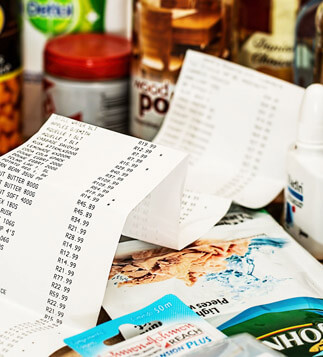Expert Tips on Saving Money on Gluten-Free Groceries
 We all know that gluten-free foods can be pricey. Keep your grocery bill stable by focusing on fresh produce and inexpensive staples.
We all know that gluten-free foods can be pricey. Keep your grocery bill stable by focusing on fresh produce and inexpensive staples.
- Elaine K. Howley, U.S. News Health 1
If you’ve recently been diagnosed with celiac disease or a gluten sensitivity, you’ll need to eliminate gluten – a protein found in wheat and other grains that gives dough its elastic properties.
Celiac disease is controlled entirely through a gluten-free diet, so eating right is an important piece of staying well.
Some people who don’t have celiac disease may also have difficulty digesting gluten, says Liz Weinandy, a registered dietitian with the Ohio State University Wexner Medical Center in Columbus. “Gluten intolerance is when a person just does not tolerate gluten for whatever reason.” In technical parlance, this gluten intolerance is known as “non-celiac gluten sensitivity.”
Over the last decade or so, going gluten-free has also become more popular, even among people who don’t have a medical reason for eliminating this sticky protein from their diet.
Whatever the reason you’re considering going gluten-free, it can be challenging for some people, especially those whose diets contain a lot of wheat-based foods and processed products.
But Lola O’Rourke, a registered dietitian and education coordinator for the Gluten Intolerance Group, a nonprofit focused on consumer support, advocacy and education based in Auburn, Washington, says “following a gluten-free diet isn’t as restrictive as you might think. While you’ll need to pay careful attention to avoiding gluten, there are plenty of ways to enjoy delicious foods by embracing the opportunity to explore new cuisines, ingredients and dishes that are gluten-free.”
Expect to Spend More
When making the change, you should also be prepared to spend a little more money at the supermarket. “There’s no denying that shopping for gluten-free foods will increase your shopping bill,” O’Rourke says, citing a 2019 study published in the journal Nutrients that found gluten-free products were 183% more expensive than “regular” gluten-containing products. “Gluten-free products from mass-market producers were 139% more expensive than the wheat-based version of the same product.”
GIG recently conducted its own survey and found that 78% of people said that the cost of gluten-free foods is the greatest challenge they face. “However, there are ways to keep the costs down. GIG is preparing to launch a new initiative to address food insecurity in the gluten-free community,” O’Rourke says.
Tips to Control Your Gluten-Free Shopping Budget
While it might not be the least expensive way to eat, there are several ways you can control the costs of going gluten-free, O’Rourke says.
Focus on naturally gluten-free fare.
Instead of opting for processed foods that are labeled as gluten-free, you’ll likely save money and get better nutritional value from eating whole foods that are naturally gluten-free.
These include:
• Fruits and vegetables.
• Yogurt, cheese, milk and other dairy products.
• Meats, poultry, fish and seafood.
• Beans, nuts and seeds.
“The cost increases associated with eating gluten-free are related to packaged substitutes for products traditionally made from wheat,” O’Rourke says. “You don’t need to avoid these products entirely, just keep a handle on how much you’re buying. It’s important to be able to enjoy moderate amounts of whatever your favorite foods might be, whether it’s a frozen gluten-free pizza or some gluten-free chocolate chip cookies.”
Look for coupons and sales.
Stock up on frozen or shelf-stable gluten-free foods when they’re on sale at the store, and keep an eye on the circulars that are mailed to your house for coupons and promotions that can reduce your spending.
Cook more at home.
If you’re used to relying more on pre-prepared items, cooking from scratch can be a great relief on your wallet,” O’Rourke says.
Cook in larger batches.
You can also save by buying in bulk and cooking in larger batches. “If you’re pressed for time or just don’t want to be cooking on a daily basis, designate a time for some bigger batch cooking, repurpose things for the following days and freeze some foods too, so you have your own personal freezer section of ready to go gluten-free meals,” O’Rourke says.
Make friends with beans.
O’Rourke says that “beans are a superstar gluten-free food in terms of versatility, budget and nutrition.” They’re also cheap and easy to store in either their dried or canned versions. Add beans to soups, salads, chili, tacos and many other dishes. Experiment and see where this cheap and healthy source of protein and fiber can take you.
Substitute gluten-free grains.
Going gluten-free means you’ll have to remove some of the least expensive items on your shopping list – grains, cereals and other products that contain wheat, rye, barely and any derivatives of them. But there are plenty of other gluten-free grain-based foods you can eat, such as:
• Teff
• Amaranth
• Quinoa
• Buckwheat
If you’re a pasta-lover, going gluten free can be a tough transition too, as dried pasta is easy to make, stores well and is inexpensive. But Emily Rice, a registered dietitian with the Ohio State University Wexner Medical Center, says that “pasta alternatives made from lentils or beans are a great source of fiber and protein, especially for those on gluten-free diets.”
Tips to Transition to a Gluten-Free Diet
While going gluten-free might elevate your shopping bill, consider it an investment in your health and wellness for the long term.
The following tips can also help make the transition a little easier:
Meet with an expert.
O’Rourke says that if you’re diagnosed with celiac disease, develop a gluten sensitivity or otherwise need to remove gluten from your diet, “the best way to get started is to meet with a registered dietitian who’s knowledgeable about gluten-free diets and can provide personalized and detailed guidance.”
Fill your plate with vegetables.
“To help maintain a healthy weight when eating gluten-free, focus on naturally gluten-free foods and aim to fill half your plate with vegetables, which are healthy and relatively low in calories,” O’Rourke says.
Read the labels.
O’Rourke warns that “you should always confirm there are no added ingredients that may contain gluten in the foods you buy and eat.” Gluten can be sneaky and often turns up in unexpected places in packaged foods, such as in salad dressings and sauces.
Do your homework.
In addition to working with someone who’s knowledgeable in this area, you should do some of your own research so you can “educate yourself on the specifics of a gluten-free diet by accessing a reputable source, such as the Gluten Intolerance Group website,” O’Rourke says. The site includes many resources on “everything from how to read food labels to cooking gluten-free grains to making your gluten-free diet a healthy one.”
Choose certified products to be sure.
“When living gluten-free, choose packaged foods that are labeled or, better yet, certified gluten-free,” O’Rourke says. GIG’s Gluten Free Certification Organization provides third-party assurance of gluten-free status that’s backed by a “rigorous certification process. There are more than 60,000 GFCO certified gluten-free products on the market today, making it easier to find gluten-free versions of all your favorite foods,” she adds.
Explore other cuisines.
Make your transition to gluten-free living a cultural exploration by experimenting with recipes from world cuisines “that include lots of naturally gluten-free ingredients and dishes, such as Indian, Mexican, Thai and Vietnamese” foods, O’Rourke says.
Build support.
Lastly, O’Rourke says that as challenging as going gluten-free might seem at first, you’re not alone: “GIG’s research shows that 23% of U.S. adult shoppers report gluten-avoidance in their home. Reach out to others you may know following a gluten-free lifestyle to build a trusted gluten-free network for shopping together or sharing recipes.”
She adds that if you need more guidance, you might also want to join a gluten-free support group to “connect and learn from others who are also gluten-free. GIG has more than 80 gluten-free support groups across the country with new ones forming regularly.”
SOURCES
The U.S. News Health team delivers accurate information about health, nutrition and fitness, as well as in-depth medical condition guides. All of our stories rely on multiple, independent sources and experts in the field, such as medical doctors and licensed nutritionists. To learn more about how we keep our content accurate and trustworthy, read our editorial guidelines.
Emily Rice, RD
Rice is a registered dietitian with the Ohio State University Wexner Medical Center in Columbus.
Lola O’Rourke, MS, RDN
O’Rourke is education coordinator for the Gluten Intolerance Group, a nonprofit focused on consumer support, advocacy and education based in Auburn, Washington.
Liz Weinandy, MPH, RDN, LD
Weinandy is a registered dietitian with the Ohio State University Wexner Medical Center in Columbus.
1 https://health.usnews.com/wellness/food/articles/how-to-save-money-going-gluten-free













